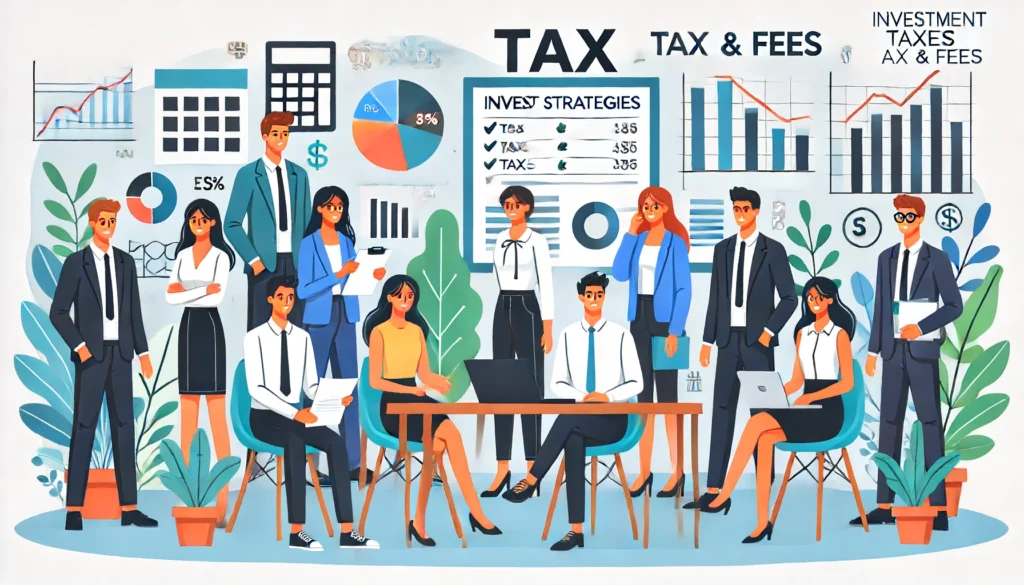Case Study: Managing Investment Taxes and Fees USA

Case Study: Managing Investment Taxes and Fees
Case Study Learning Objectives:
In this case study, users will explore strategies to minimize taxes and fees on stock investments, helping them optimize their portfolios for tax efficiency.
Case study overview:
Case Study Information:
John is a 60-year-old investor nearing retirement who wants to optimize his portfolio for tax efficiency. He needs to understand the impact of capital gains taxes and the benefits of tax-advantaged accounts like IRAs and 401(k)s.
Hypothetical Scenario:
John needs to optimize his portfolio by minimizing taxes and fees on his stock investments. He will review tax-efficient investment strategies used by high-net-worth individuals to guide his process.
Part 1: Understanding Capital Gains Taxes
Information for Part 1:
Capital gains taxes impact investment decisions by reducing the net returns on sold assets. Understanding the difference between short-term and long-term capital gains taxes is crucial.
- Short-Term Capital Gains: Taxed at ordinary income tax rates for assets held for one year or less.
- Long-Term Capital Gains: Taxed at lower rates for assets held for more than one year. Rates vary based on taxable income (0%, 15%, or 20%).
Questions for Part 1:
- How do capital gains taxes impact investment decisions?
- What strategies can John use to minimize capital gains taxes on his investments?
Part 2: Benefits of Tax-Advantaged Accounts
Information for Part 2:
Tax-advantaged accounts like IRAs and 401(k)s offer significant benefits for tax-efficient investing.
- Traditional IRAs: Contributions may be tax-deductible, and investments grow tax-deferred until withdrawals are made in retirement.
- Roth IRAs: Contributions are made with after-tax dollars, but qualified withdrawals are tax-free.
- 401(k)s: Employer-sponsored retirement plans with potential employer matching contributions and tax-deferred growth.
Questions for Part 2:
- What are the benefits of using traditional IRAs and Roth IRAs for tax-efficient investing?
- How can 401(k) contributions and employer matching help John optimize his portfolio for retirement?
Part 3: Applying Knowledge to the Real World
Information for Part 3:
Understanding real-world examples of tax-efficient investment strategies used by high-net-worth individuals can help John optimize his portfolio.
Real-World Example:
Tax-Efficient Investment Strategies:
- High-net-worth individuals often use tax-advantaged accounts, tax-loss harvesting, and strategic asset allocation to minimize taxes and fees.
- Example: Jane, a high-net-worth investor, uses a combination of traditional and Roth IRAs, tax-loss harvesting, and municipal bonds (which are often tax-exempt) to optimize her portfolio for tax efficiency.
Questions for Part 3:
- How can John implement tax-efficient investment strategies similar to those used by high-net-worth individuals?
- What steps should John take to optimize his portfolio for tax efficiency as he nears retirement?
Mambo muhimu ya kuchukua:
- Capital Gains Taxes: Impact investment decisions and can be minimized through strategies like tax-loss harvesting and strategic timing of asset sales.
- Tax-Advantaged Accounts: Traditional IRAs, Roth IRAs, and 401(k)s offer significant tax benefits for retirement savings.
- Tax-Efficient Strategies: Using a combination of tax-advantaged accounts, tax-loss harvesting, and tax-efficient assets can help optimize portfolios.
Tips, Advice, and Best Practices:
- Research Thoroughly: Understand the tax implications of different investment strategies.
- Maximize Contributions: Take full advantage of tax-advantaged accounts like IRAs and 401(k)s.
- Employ Tax-Loss Harvesting: Offset capital gains with losses to reduce taxable income.
- Consult Professionals: Seek advice from tax advisors to develop personalized tax-efficient investment plans.
Closing Remarks:
Congratulations on completing this case study! By understanding and applying tax-efficient investment strategies, you have gained valuable insights into optimizing your portfolio for tax efficiency. Keep researching, stay informed, and use tax-efficient strategies to achieve your financial goals. Happy investing!

